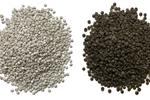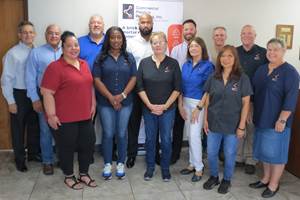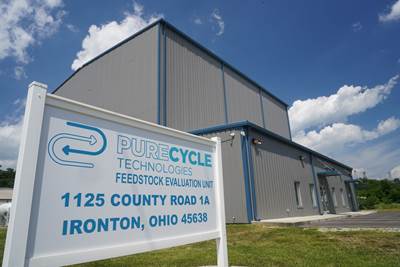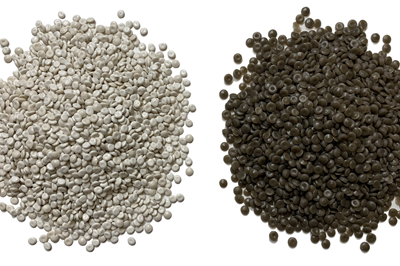How This Processor Established a Circular Economy for Post-Industrial Reclaim
PolyFlex is walking the talk of “circularity” by using its post-industrial reclaim in material-handling products for automated manufacturing.
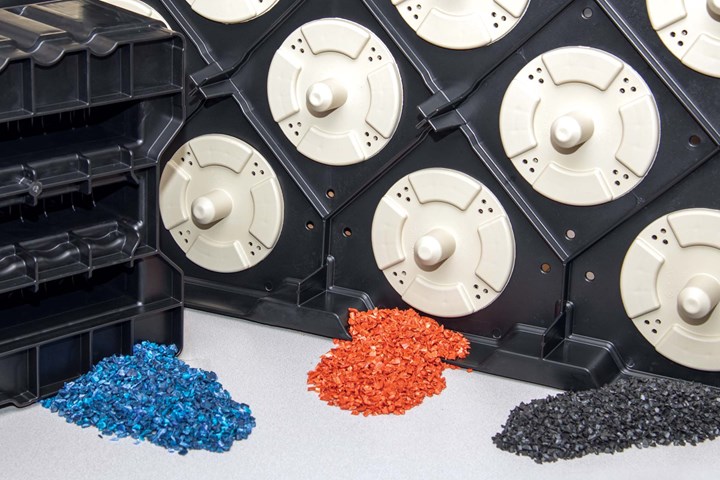
PolyFlex brings post-industrial reclaim up to ASTM standards, which enables it to be used again in manufacturing automation.
PolyFlex Products, based in Farmington Hills, Mich., believes post-industrial reclaim (PIR) is overlooked in the circular economy discussion. “We, the industrial side, are kind of the forgotten plastics in recycling,” says Ken Bylo, executive v.p. and partner at PolyFlex. “We’re making a concerted effort to change that.”
PolyFlex provides injection molding, urethane casting, and thermoforming processing services. The company is also committed to the use of PIR in manufacturing automation products by developing a circular lifecycle that brings the recycled industrial plastics up to ASTM standards, which enables them to be used again in such products. Bylo says his company is focused on removing the stigma of using recycled industrial plastics.
PolyFlex has several agreements with global manufacturers that are serious about taking responsibility for the materials they use and their company’s environmental impact. These recycled plastics are returned to a high level of duty, instead of being relegated to a landfill.
Getting Customer Buy-In
PolyFlex has four manufacturing facilities in the U.S., as well as a facility in Mexico and a sales office in Germany. It employs 110 overall. Throughout its 18-year history, PolyFlex (polyflexpro.com) has focused mainly on material-handling products (dunnage, trays, racks, returnable containers) and automated manufacturing system components for the automotive and other industries. The firm began exploring recycling options for industrial scrap several years back.
“Not all the materials that we use for these applications are commodities,” Bylo says. “Very often they're engineered resins and that's not as easy to find a home for in the recycling world. We recycle polypropylene and polyethylene, but we also do a lot of thermoplastic polyurethane— we use a wide range of materials.”
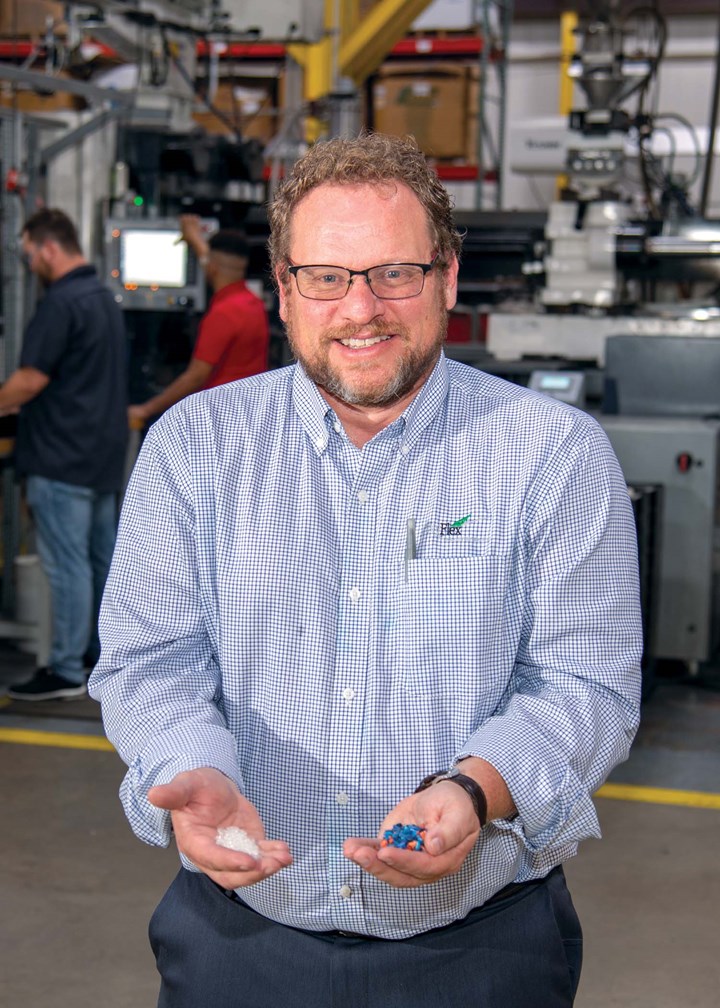
Ken ByIo, executive v.p. and partner at PolyFlex Products, holding virgin and reground resin materials in the Farmington Hills plant.
Bylo says PolyFlex decided that if it could control the stream of material internally, they could reclaim it at the end. The task then becomes finding the right application and modifying the materials by adding some virgin content or some type of additive to bring it up to the spec that is required for the application.
But it did take some convincing of its customers.
PolyFlex decided if they can control the stream of material, they can reclaim it at the end.
“Our customer base has always had kind of a bad taste for recycling materials or using regrind, because there has been some unscrupulous use of it,” Bylo explains. “For instance, where reclaim is just being put in and there's no testing, technology, or science behind it. And they’re just buying reclaim on the open market and trying to put it into a new product. With some of those reclaimed materials, you lose properties. It would fail in the field if it isn't applied properly.”
PolyFlex set out to prove that PIR can have a home. The company carried on with recycling projects for several years, but interest from customers really started to increase in just the past year and half when the talk of sustainability and the circular economy became a focus. Bylo says this has given the company more of a platform to have the conversation about recycling.
“What we’re getting the customers to understand is that the material at the end of a program—be it three years, four years, five years—there's a value to that material, it's not garbage,” he explains. “So it’s a new terminology of lifecycle recycling. We're doing that on the industrial side and converting industrial scrap back into new products. We've been making a lot of strides in that.”
For example, a bin that was created with a polymer designed to withstand the punishment of constantly carrying heavy materials or objects during the manufacturing process will experience natural degradation over time from customary wear and tear and from environmental exposure. At this lifecycle stage, it will exhibit properties that are not compatible with its original ASTM standards, rendering it unsuitable for its original use.
These plastics are ground down using a specified regrind process to yield pellets approximately 6 mm in size that are ready for use in new plastic products. A percentage of additive materials is added to the regrind to raise the specs of these repurposed materials to ASTM standards for the identified use.
PolyFlex is also having discussions with customers regarding design for recycling, such as limiting metal fasteners if possible and trying not to combine dissimilar materials or create an assembly that is not easily taken apart. In addition, the company is working on building a knowledge base of recycled materials.
“Our customer base has always had a bad taste for recycling materials or using regrind because there has been some unscrupulous use of it.”
“If the customer is concerned about the level of regrind content we're putting into a product, we're going to have the data to back it up to make sure that the performance of the product doesn't suffer,” notes Daniel Walker, v.p. of continual improvement for PolyFlex.
Creating a Network
Instead of investing in a bunch of recycling equipment and becoming a recycler themselves, PolyFlex took a different approach. It is working within the supply chain to make sustainability a reality.
“We did add large grinding equipment in our Tennessee facility and we have smaller capacity here in Michigan. We have some testing equipment here. But that isn't our main focus to recycle it,” Bylo said. “Quite honestly, we discussed it internally and decided a third party would take any bias out of testing. And so it is something we would rather have done outside.”

Conducting part inspection to ensure quality and dimensional stability.
PolyFlex sought to create a network of PIR suppliers. It works with companies that specialize in scrap and also finds local toll grinders in the area where the scrap material is located. A big focus is to keep it as local as possible instead of having to make a huge investment in shipping pounds of material.
For example, if 17 truckloads of scrap slated for recycling are collected in Mexico, it makes good environmental sense to regrind it at a local facility and have three trucks of regrind to transport.
“We have companies that do reprocessing for us if we have to take it to a pellet form vs. a grind,” Bylo said. “There's a lot to it, no question. You can see why there was some reluctance over the years, because it takes a lot of coordination to get it done. But once it's in place, it takes a lot of those initial hurdles out of the way.”
PolyFlex’s new repurposed industrial plastics are a budding revenue stream. In addition to using them in its own products, PolyFlex has an agreement with a global automaker to reclaim obsolete industrial plastics used in their manufacturing automation processes to reuse the plastics in custom products for the automaker. It also is in talks with a global Tier 1 automotive supplier to provide similar services. The plan for the regrind/pellets is to convert it for PolyFlex’s own use to make new products for the automakers.
“We had a large TPU program that was used by one of the OEMs for transmissions,” Bylo says. “We were able to take that material at the end of the lifecycle.” Out of 133,000 lb worth of product returned to PolyFlex, they were able to recover 128,000 lb of material, which was a blend of virgin and regrind. “It was a substantial project and even with factoring in the costs, it was a net gain in value for both us and our customer,” Walker notes.
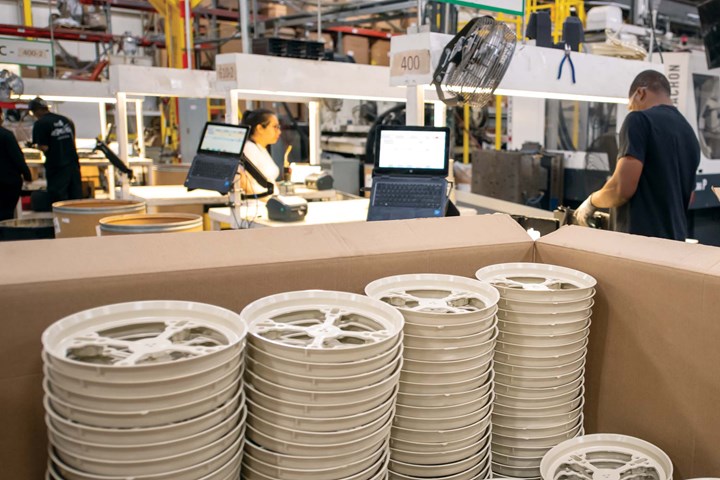
Parts made with post-industrial reclaim awaiting assembly into industrial trays.
One of the items that Walker is working on is a carbon-footprint scorecard for customers. This is where they can show customers how much they can save in energy use and environmental impact by recycling that material, even taking into account all the factors such as regrinding and transporting it.
The four basic metrics it measures include reduction in greenhouse gases, reduction of electricity consumption, reduced petroleum use, and reduction of landfill.
“We’re telling our customers, ‘When you're done with your product that we produce for you, we would like an opportunity to recall it, grind it up, put it back into product for you in the future,’” Bylo said. “And we're finding ways to do it economically, where both the customer and PolyFlex benefit financially from the exchange, which has been a missing component in a lot of recycling movements in our society.”
Related Content
Avoid Four Common Traps In Granulation
Today, more than ever, granulation is an important step in the total production process. Our expert explains a few of the many common traps to avoid when thinking about granulators
Read MoreRecycling: What's Ahead in Advanced Sorting Technology
As the industry tries to ramp up recycling, there are several innovative sorting solutions in the offing—ranging from enhanced optical sorting technologies and chemical tracers to advanced solutions based digital watermarks and artificial intelligence.
Read MoreCompatibilizers Aid Recycling & Upcycling of Mixed Resins
Compatibilizers are proving their worth in boosting critical properties such as impact/stiffness balance of PCR and PIR blends of polyolefins and other plastics.
Read MoreInside the Florida Recycler Taking on NPE’s 100% Scrap Reuse Goal
Hundreds of tons of demonstration products will be created this week. Commercial Plastics Recycling is striving to recycle ALL of it.
Read MoreRead Next
Making Polypropylene the Next Big Thing in Recycling
PureCycle Technologies’ solvent-based recycling process returns polypropylene to a pristine state.
Read MoreSpecifying PCR? Find Answers to These Eight Questions
Understanding how to work with the PCR available today is critical as packaging and other products are being redesigned for circularity.
Read MoreExxonMobil to Build its First Large-Scale Plastic Waste Advanced Recycling Facility
To be located at its Baytown, Texas site, the new facility is slated for startup by end of 2022.
Read More


